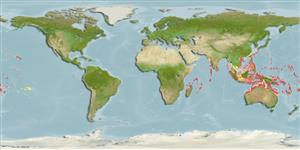>
Acanthuriformes (Surgeonfishes) >
Acanthuridae (Surgeonfishes, tangs, unicornfishes) > Acanthurinae
Etymology: Acanthurus: Greek, akantha = thorn + Greek, oura = tail (Ref. 45335).
Environment: milieu / climate zone / depth range / distribution range
Ecologia
marino; salmastro associati a barriera corallina; distribuzione batimetrica 0 - 30 m (Ref. 9710), usually 2 - 15 m (Ref. 27115). Tropical; 23°C - 28°C (Ref. 27115); 30°N - 24°S, 39°E - 143°W
Indo-Pacific: East Africa, including the Mascarene Islands (Ref. 37792) to the Tuamoto Islands, north to Ryukyu Islands, south to southern Great Barrier Reef. Not occurring in the Red Sea.
Length at first maturity / Size / Peso / Age
Maturity: Lm 18.4 range ? - ? cm
Max length : 45.3 cm FL maschio/sesso non determinato; (Ref. 125599); peso massimo pubblicato: 2.7 kg (Ref. 125599)
Spine dorsali (totale): 9; Raggi dorsali molli (totale): 25-28; Spine anali 3; Raggi anali molli: 23 - 26. Color in life dark brown without lines on body or spots on head (one phase is purplish grey); horizontal black band behind upper gill opening absent on juveniles <6 cm SL; elongate purple band may be present anterior to dorsal origin; caudal fin brown; outer third of pectoral fin pale. Species with gizzard-like stomach.
Occurs in clear lagoon and seaward reefs around isolated coral heads. Solitary or in small groups (Ref. 90102). Prefers sandy bottoms of bays and lagoons rather than the coral reefs like most other Acanthuridae. The species is sometimes poisonous (Ref. 4795). Caught with nets (Ref. 30573). Minimum depth reported taken from Ref. 128797.
Probably spawn in pairs (Ref. 240).
Randall, J.E., 1987. Three nomenclatorial changes in Indo-Pacific surgeonfishes (Acanthurinae). Pac. Sci. 41(1-4):54-61. (Ref. 1921)
IUCN Red List Status (Ref. 130435)
Threat to humans
Poisonous to eat (Ref. 4795)
Human uses
Pesca: commerciale; Acquario: Commerciale
Informazioni ulteriori
BibliografiaAcquacolturaProfilo di acquacolturaVarietàGeneticaElectrophoresesEreditarietàMalattieElaborazioneNutrientsMass conversion
Strumenti
Special reports
Download XML
Fonti Internet
Estimates based on models
Preferred temperature (Ref.
123201): 25.3 - 29.3, mean 28.4 °C (based on 2616 cells).
Phylogenetic diversity index (Ref.
82804): PD
50 = 0.5000 [Uniqueness, from 0.5 = low to 2.0 = high].
Bayesian length-weight: a=0.02344 (0.01969 - 0.02790), b=2.95 (2.91 - 2.99), in cm total length, based on LWR estimates for this species (Ref.
93245).
Trophic level (Ref.
69278): 3.0 ±0.40 se; based on food items.
Generation time: 1.8 ( na - na) years. Estimated as median ln(3)/K based on 1
growth studies.
Resilienza (Ref.
120179): Alto, tempo minimo di raddoppiamento della popolazione meno di 15 mesi (Preliminary K or Fecundity.).
Fishing Vulnerability (Ref.
59153): Low to moderate vulnerability (26 of 100).
Nutrients (Ref.
124155): Calcium = 52.9 [22.4, 157.8] mg/100g; Iron = 0.704 [0.257, 1.764] mg/100g; Protein = 18.9 [17.9, 20.0] %; Omega3 = 0.119 [0.053, 0.257] g/100g; Selenium = 16.6 [5.6, 60.7] μg/100g; VitaminA = 34.8 [9.9, 119.3] μg/100g; Zinc = 2.52 [0.80, 4.71] mg/100g (wet weight);
